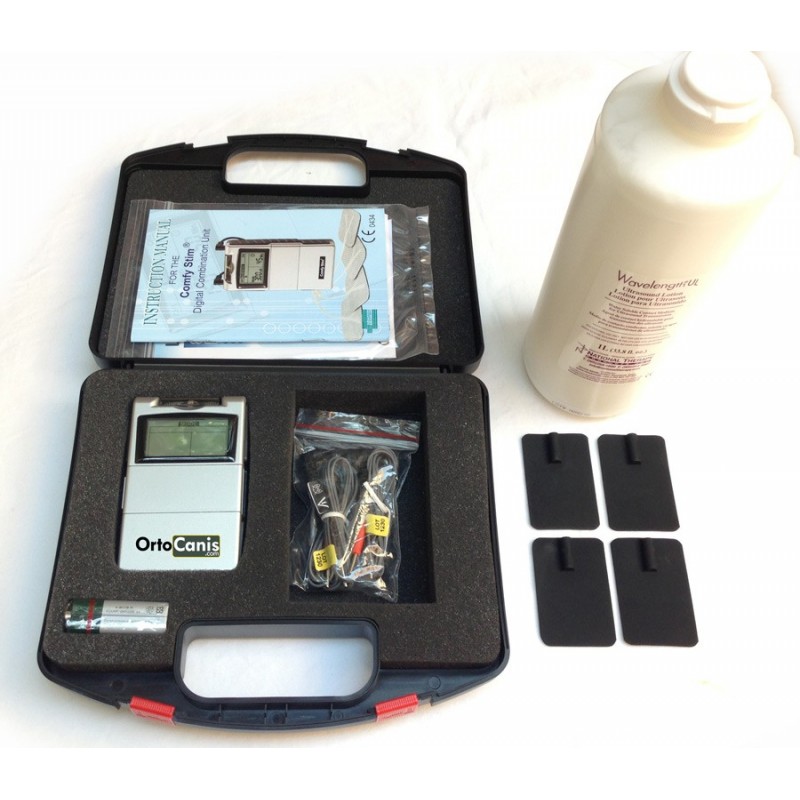Electrostimulation in dogs


Electrostimulation for muscle potentiation
Electrostimulation is a very useful tool to enhance the muscles of a dog that has suffered an injury or surgical intervention and as a result has muscle atrophy.
We can use electric current to stimulate the muscles, enhance it and make it work, it is specifically indicated in cases of muscle atrophy, and especially in cases where the dog can not do active work. If the dog can do active work, electrotherapy will be a support, never the main source of work.
Form of the impulse that we will use will be the Rectangular, symmetrical biphasic the main authors indicate it: Thepaut Mathieu 1992, Kramer 1984, Bircan 2002
Human electrostimulation apartments can be adapted to electrostimulate dogs without too many problems, but we must ensure that we can vary the frequencies, and especially the amplitudes of the electrical impulse to adapt well to the characteristics of the dog.
There are no good studies of Cronaxia in dogs, the approximate values are 0.3 human, 0.2 Horses and in dogs by studies of less depth intuit similar values;
Sawaya – Meallier 2006, Brodart 1998, Coarasa 1999, Ramon 2007
The Intensity according to Hultaman 1983, and Ogino 2002 should be elevated with visible contraction, without reaching the limit of pain but discomfort. The dog must comfortably withstand the session but the muscles must work intensely.
The frequency will be marked according to the objective, various authors validate this option: Pougheon 1992, Busko 1989, Vanderthommen 2002.
| Objective | Frequency | Treatment time | Standby time |
| Relaxation: | 5 Hz | Continuous | 0 |
| Heating: | 5 Hz | Continuous | 0 |
| “Endurance”: | 10-20 Hz | 9 | 2 |
| Atrophy: | 33 Hz | 6 | 6 |
| Strength: | 50- 100 Hz | 5 | 25 |
| Explosive force: | 100-200 Hz | 3 | 30 |
The parameters may vary slightly according to individual cases.
Rest time can be adjusted if it is active, it is advisable to use ramps before strong muscle contraction.
The intensity should always be the maximum with relative comfort.
Total time between 10 and 30 minutes depending on the phase of the injury, fatigue the muscles excessively does not help to enhance the muscles correctly.
It is important to have a device that meets all the requirements, if it is going to be used by a canine rehabilitation center or veterinary hospital, a more professional desktop apartment is recommended and with it we can use specific programs for each of our patients.
The use of rubber electrodes and contact gel is equally recommended in animals with hair.
Orthocanis Veterinary Team
Recent Posts
What side effects do anti-inflammatories have in dogs?
Anti-inflammatory drugs, called NSAIDs (nonsteroidal anti-inflammatory drugs), are the most commonly prescribed pain reliever in…
Exercises to strengthen the dog’s hind legs
Improving the muscles of the hind limbs in dogs is an interesting option both in…
What to do with a dog that has back problems
Dogs can have health problems related to their limbs. But they can also have back…
Total or partial rupture of cruciate ligament in dogs
One of the most frequent injuries that dogs usually suffer is the rupture of one…
Solutions to hip dysplasia in dogs
Hip dysplasia in dogs is one of their most common inherited bone diseases. It is…
How to treat patellar luxation in dogs?
There is talk of patellar dislocation in dogs, when the patella, a small bone located…
